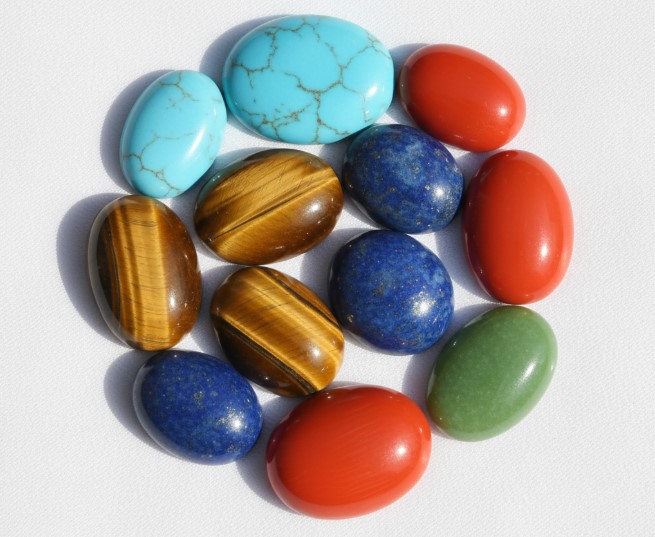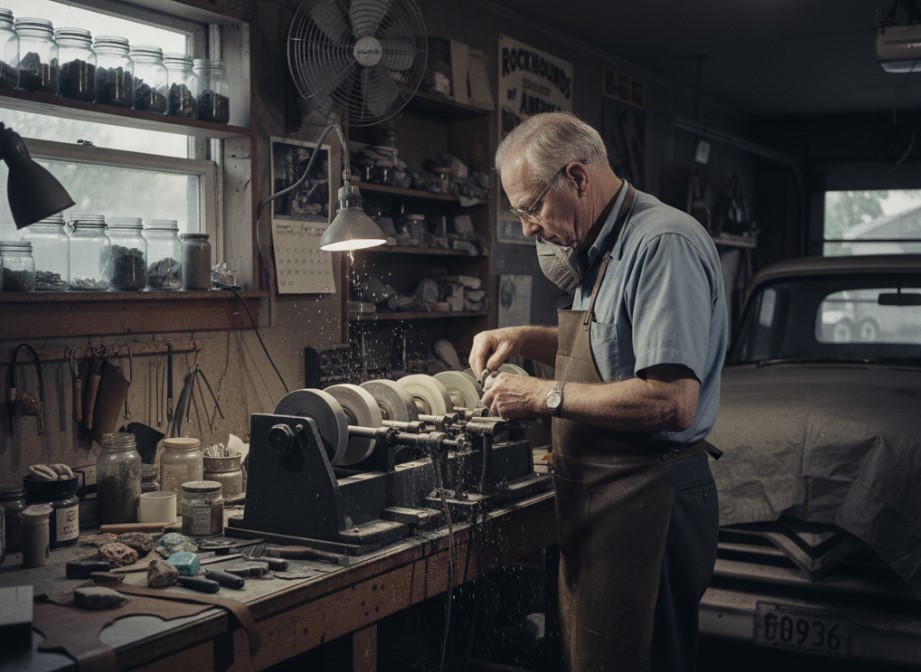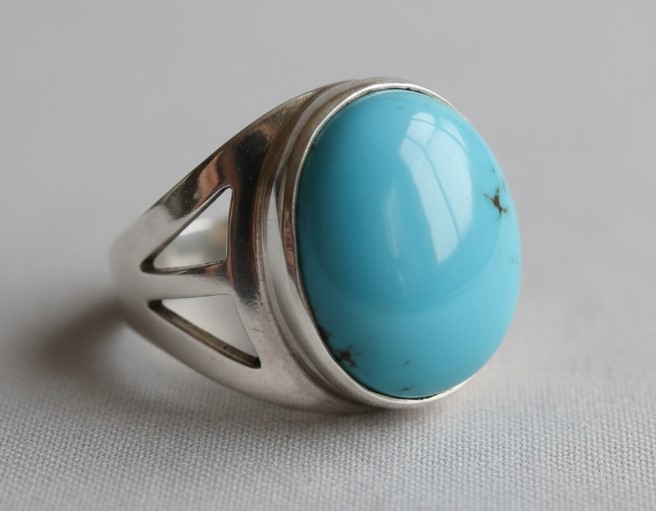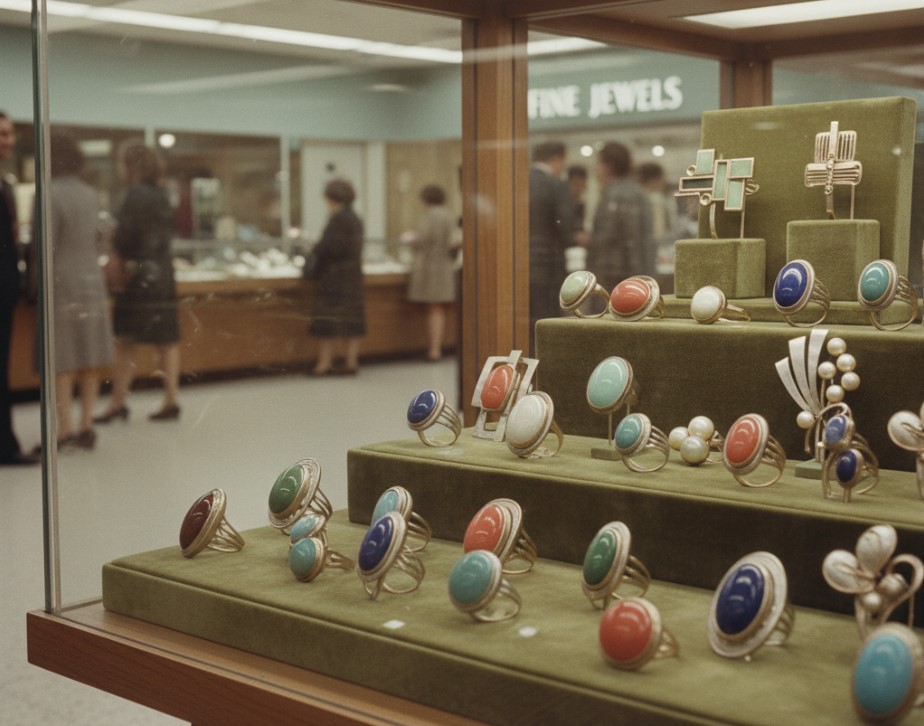Cabochon Cutting: How Mid-Century Jewelers Shaped Raw Stone

The first thing anyone notices about mid-century jewelry is the color. Not sparkle-color. Deep pools of turquoise blue, tiger's eye amber chatoyance, lapis lazuli midnight. Smooth, domed, hypnotic. The technical term is cabochon, from the French caboche meaning "head," and by 1955 these polished domes dominated American jewelry in a way faceted stones never had.
Here's what the numbers looked like: Between 1950 and 1965, cabochon production in the United States increased roughly 400% according to lapidary industry records. The American jewelry market imported approximately 2 million carats of turquoise annually by 1960, most of it destined for cabochon cutting. Tiger's eye from South Africa entered the market at $2-5 per pound for rough material—a fraction of what transparent gem-quality stones cost. The equipment to process these opaque materials already existed in every lapidary workshop. Grinding wheels, polishing compounds, dop wax. No precision faceting machines required.

The Manufacturing Reality: Ancient Technique Meets Suburban Garage
Cabochon cutting wasn't new in the 1950s. It's arguably the oldest gem processing technique humans developed—evidence exists from ancient Egypt, Ming Dynasty China, medieval European crowns. Before grinding wheels arrived in the 1400s, every gemstone got shaped into a smooth dome because that's what you could accomplish by rubbing stone against stone.
What changed in mid-century America was volume. The lapidary hobby movement exploded during the 1950s, fueled by post-war prosperity and returning servicemen looking for hands-on skills. By 1960, an estimated 200,000 Americans owned lapidary equipment. The Genie by Diamond Pacific-a six-wheel cabbing machine that became the industry standard-retailed for around $300 (roughly $3,000 in 2026 dollars). Workshops appeared in garages across suburban California, Arizona, New Mexico.

The process remained remarkably consistent across all production tiers. Start with a slab of material, cut with a diamond trim saw. Mark the outline using a template-ovals dominated because the human eye forgives asymmetry in ellipses better than circles. Grind the rough shape on coarse wheels (80-220 grit silicon carbide initially, diamond wheels after 1954). Progress through finer grits-320, 600, 1200, 3000. Polish with oxide compounds on leather or canvas. The entire sequence took 20-45 minutes depending on material hardness and desired finish quality.
Commercial operations in Idar-Oberstein, Germany had been producing calibrated cabochons since the 1800s-standard sizes like 30mm × 40mm ovals that fit pre-made jewelry settings. American hobbyists and small studios couldn't compete on price with German mass production, but they could offer custom work and unusual materials. The making cabochons process involves specific grit progression sequences that determine final polish quality.
Material Economics: Why Turquoise Flooded American Jewelry Cases
The cabochon boom ran on specific stones. Turquoise from Nevada, Arizona, New Mexico. Tiger's eye from South Africa. Lapis lazuli from Afghanistan (before Soviet invasion complicated supply chains). Carnelian, coral, jade, agate. Materials that were opaque or translucent, not transparent. Materials where color and pattern mattered more than light refraction.
Transparent stones went to faceting because facets maximize brilliance—the way light bounces internally before exiting. Sapphires, rubies, diamonds, emeralds. These needed precision cutting at specific angles to optimize optical performance. Faceting equipment cost more, required more skill, took longer per stone.
Opaque stones couldn't transmit internal light, so faceting them accomplished nothing. A cabochon cut maximized surface area for viewing color and pattern. It also suited stones with optical phenomena-asterism (star effects), chatoyancy (cat's eye effects), labradorescence, adularescence. These required domed surfaces to concentrate light and display the effect properly.
The pricing differential drove purchasing decisions. Rough turquoise in the 1950s ran $3-15 per pound depending on quality and mine source. Rough sapphire suitable for faceting started at $50 per carat. A hobbyist could buy 450 carats of turquoise for what one carat of facet-grade sapphire cost. The finished jewelry reflected this—turquoise cabochon rings retailed for $25-75, while faceted sapphire rings started around $300.
Native American silverwork drove substantial turquoise demand. Navajo, Zuni, and Hopi smiths incorporated cabochons into squash blossom necklaces, concho belts, cuff bracelets. These pieces entered mainstream American fashion during the 1950s-70s, creating a feedback loop that increased both demand and production. By 1970, turquoise cabochon jewelry represented an estimated $800 million market segment.
Designer Adoption: When Cartier Put Panthers on Emerald Cabochons
High-end jewelry houses noticed. Jean Schlumberger at Tiffany & Co. mixed large cabochon stones with faceted diamonds-juxtaposing precious and semi-precious materials for color contrast. Bulgari's 1950s designs featured cabochon emeralds and rubies paired with pavé diamonds. Cartier produced the three-dimensional panther brooch in 1948-a gold panther with black enamel spots stretched across a massive cabochon emerald, with emerald cabochon eyes. Created for the Duchess of Windsor, it launched Cartier's "great cat" series that became synonymous with the house.
Van Cleef & Arpels developed their invisible setting technique in 1935, allowing stones to sit flush without visible metal prongs. This worked for both faceted and cabochon stones, and the firm produced elaborate pieces mixing cut types. Their ballerina brooches—figures in tutus made from graduated stones—remained popular through the 1960s.
American designers emerged as serious players. Trabert & Hoeffer-Mauboussin created cabochon pieces for Hollywood actresses. The firm's cofounder William Howard Hoeffer purchased the Star of Burma-an 83-carat cabochon star ruby-and loaned it to the 1938 film Vogues of 1938 for the opening sequence. The Technicolor format showcased the ruby's deep red and prominent star effect, effectively advertising cabochon glamour to millions of moviegoers.
Georg Jensen's Scandinavian modernist designs incorporated cabochon amber, moonstone, and other materials in sterling silver. The clean lines and organic forms of Danish modern translated well to jewelry, and Jensen's pieces from the 1950s-60s epitomized understated mid-century elegance.
The modernist jewelry movement in Greenwich Village ran parallel to commercial production. Sam Kramer, Ed Weiner, Art Smith created abstract pieces in silver with cabochon stones-sometimes semi-precious gems, sometimes taxidermists' glass eyes or found materials. These artists treated jewelry as wearable sculpture, prioritizing form and concept over material value. Their work influenced studio jewelers nationwide and established cabochons as legitimate artistic elements rather than just budget alternatives to faceted gems.

Technical Standards: The One-Third Rule and Why Proportions Mattered
Quality cabochon cutting required attention to proportions. The dome height should equal roughly one-third of the stone's width for pleasing proportions-what lapidaries call a "standard dome." Lower domes (one-quarter width) appeared in some commercial work. Higher domes (one-half width or more) created "high dome" or "bullet" cabochons that amplified optical effects in cat's eye or star stones.
The base needed to be flat and parallel to the table (top) for proper setting in jewelry. Most cabochons had straight sides (the girdle) meeting the dome in a smooth curve. Some featured undercut girdles or sloped bases depending on setting requirements. The lapidary equipment used for shaping determined what profiles were practical to produce consistently.
Polishing posed the main challenge. Different materials required different compounds-cerium oxide for most quartz varieties, tin oxide for jade, chrome oxide for harder materials. Under-polishing left visible scratches. Over-polishing created rounded edges that looked sloppy. The compound had to match both the stone and the polishing pad (leather, canvas, felt). This knowledge came from experience-no chart could account for every variable.
Dop wax held the stone during grinding and polishing. The stone got attached to a wooden dowel (dop stick) with temperature-sensitive wax, allowing the cutter to control orientation without touching the stone directly. Dopping wax temperature control became critical for preventing thermal shock in heat-sensitive materials. Remove the wax too quickly with excessive heat, and thermal expansion could crack the stone.
Water requirements for lapidary work expanded significantly during this period. Dry grinding created dangerous silica dust. Wet grinding kept dust suppressed and prevented heat buildup that could crack stones. Most cabbing machines incorporated water drip systems or relied on manual spray bottles. Commercial operations needed proper drainage systems to handle the volume of stone slurry generated.
Market Segmentation: From Department Stores to Hollywood
By 1960, three distinct cabochon markets existed. Mass-produced commercial cabochons from overseas facilities provided jewelers with inventory-calibrated sizes in common materials, consistent quality, low prices. These stones filled department store jewelry cases and mail-order catalogs.

American studio work occupied the middle tier-custom cabochons in unusual materials, higher polish quality, unique shapes. These went to jewelers who wanted distinctive pieces or collectors who appreciated craft. Pricing reflected skill and material cost but remained accessible to middle-class buyers.
High-end designer work topped the pyramid-exceptional stones in platinum and gold settings, often mixing cabochons with faceted diamonds. These pieces appeared in Vogue editorials and on Hollywood actresses. The cabochon itself might be turquoise or coral, but the setting and accompanying stones pushed the total price into luxury territory.
The hobby market existed in parallel—enthusiasts who cut their own cabochons using equipment in home workshops. Rock collecting and lapidary work intersected naturally. People found agate nodules while hiking, bought rough at gem and mineral shows, traded material through clubs. The resulting cabochons went into personal jewelry, gifts, or small-scale sales at craft fairs.
Cultural Context: Material Honesty Meets the Space Age
The cabochon aesthetic aligned with mid-century modern design principles broadly. Organic forms over ornate decoration. Material honesty-letting stones be what they are rather than trying to make them sparkle like diamonds. Color as a primary design element. Isamu Noguchi's stone sculptures employed similar logic-shape the material to reveal its inherent character, don't impose arbitrary forms.
The space age and atomic age influenced motifs but not fundamental technique. Starburst patterns appeared on jewelry, but the stones themselves remained traditional cabochon forms. What changed was the willingness to pair semi-precious cabochons with precious metals and diamonds-a democratization of jewelry design that paralleled mid-century furniture becoming available to middle-class consumers rather than only the wealthy.
The lapidary movement represented a specific iteration of the American craft revival. Returning WWII veterans wanted tangible skills and hobby income. Lapidary equipment manufacturers advertised directly to this demographic-"Start Your Own Profitable Lapidary Business" headlines ran in Popular Mechanics and similar magazines. The reality involved more garage workshops than thriving businesses, but the equipment sold steadily.
By the late 1960s, approximately $800 million in turquoise cabochon jewelry alone moved through American retail annually. This excluded tiger's eye, lapis, jade, agate, and other materials in the cabochon format. The total cabochon jewelry market likely exceeded $2 billion-a substantial industry segment that emerged primarily in the 15 years following WWII.
Technical Documentation: What Survived From the Genie Era
Vintage lapidary equipment from the mid-century period remains functional today. The Genie machines still appear at estate sales and online marketplaces. Silicon carbide wheels eventually got replaced by diamond wheels after Paul Blackmer's 1954 patent for sintered metal-bond diamond wheels, but the basic six-wheel configuration persisted. General Electric's 1954 synthesis of industrial diamonds dropped abrasive costs over the following decades, making diamond wheels economically viable for hobbyist use by the 1970s.
The materials themselves changed less than the equipment. Turquoise mining in the American Southwest continues, though many historic mines closed when demand declined post-1970s. Tiger's eye from South Africa remains available. Lapis from Afghanistan became complicated after Soviet invasion, then Taliban control, then ongoing conflict-supply fluctuated with geopolitics. Chinese suppliers filled some gaps with lower-grade material.
The knowledge base for cabochon cutting dispersed as the hobby declined. Lapidary clubs still exist but membership trends elderly. The skills remain accessible—YouTube videos demonstrate every stage of the process, and equipment manufacturers maintain extensive documentation. But the social networks that once connected thousands of hobbyists across the country largely dissolved.
For those researching stone identification or hardness testing, mid-century lapidary guides remain valuable references. The materials haven't changed, and the Mohs scale still works the same way it did in 1955. What's missing is the cultural context-the sense that cutting cabochons represented participation in a broader movement, not just an isolated craft skill.
Manufacturing Economics Today: Where the Hobby Went
Modern cabochon production concentrates in China and India, where labor costs enable price points American producers can't match. A calibrated turquoise cabochon from Chinese suppliers runs $0.50-2.00 depending on size and grade. American studio work starts around $15 for equivalent pieces. The quality differential exists but doesn't justify the 7-15× price gap for most buyers.
Small-scale American lapidary work survives in specific niches-museum-quality pieces for high-end jewelers, custom stones for commission work, teaching and demonstration. The equipment remains the same-six-wheel cabbing machines, trim saws, dop stations. Diamond wheels and polishing pads cost more than the silicon carbide and felt of the 1950s, but they last longer and produce better results.
The aesthetic never fully disappeared. Cabochon stones appear consistently in jewelry design, even when faceted stones dominate fashion. Opals, moonstones, and star sapphires require cabochon cutting to display their optical effects. Turquoise maintains cultural significance in Southwestern jewelry. Jade cabochons remain standard in Asian markets.
What ended was the assumption that middle-class Americans would take up lapidary as a hobby. The 1950s-60s represented a unique convergence-available leisure time, cheap rough material, affordable equipment, social structures (clubs, shows, publications) that supported the hobby. When those conditions changed, cabochon production migrated to professional commercial operations overseas.
The mid-century period remains the reference point for American lapidary work. The techniques, materials, and standards established then still guide contemporary practice. The visual language of cabochon jewelry from that era-bold colors, simple settings, organic forms-continues influencing designers. The story of how smooth polished stones became central to American jewelry aesthetics over a 15-year span documents a moment when craft, commerce, and culture aligned in ways that haven't quite repeated since.